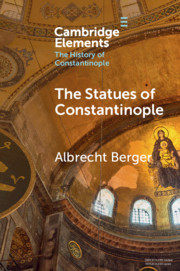22 Literature
Anderson, B., ‘Classified knowledge: the epistemology of statuary in the Parastaseis Syntomoi Chronikai’, Byzantine and Modern Greek Studies 35 (2011), 1–19
Anderson, B. ‘Leo III and the Anemodoulion’, Byzantinische Zeitschrift 104 (2011), 41–54
Andreae, B., and Conticello, B., ‘Skylla und Charybdis: Zur Skylla-Gruppe von Sperlonga’, Abhandlungen der Geistes- und Sozialwissenschaftlichen Klasse, no. 14 (1987)
Asutay-Effenberger, N., Die Landmauer von Konstantinopel – İstanbul, Millennium Studies 18 (Berlin: De Gruyter, 2007)
Bär, S., ‘Museum of words: Christodorus, the art of ekphrasis and the epyllic genre’ in Baumbach, M., Bär, S. (eds.), Brill’s Companion to Greek and Latin Epyllion and its Reception (Leiden and Boston: Brill, 2012), 447–71
Bardill, J., Constantine, Divine Emperor of the Christian Golden Age (Cambridge: Cambridge University Press, 2012)
Bardill, J. ‘The Palace of Lausus and nearby monuments in Constantinople: a topographical study’, American Journal of Archaeology 101 (1997), 67–95
Bassett, S., ‘ “Curious art”: myth, sculpture, and Christian response in the world of Late Antiquity’ in Leppin, H., Antike Mythologie in christlichen Kontexten der Spätantike, Millennium Studies 54 (Berlin: De Gruyter, 2015), 240–61
Bassett, S. ‘Excellent offerings: the Lausos Collection in Constantinople’, The Art Bulletin 82 (2000), 6–25
Bassett, S. The Urban Image of Late Antique Constantinople (Cambridge: Cambridge University Press, 2004)
Belobrova, O. A., ‘Статуя византийского императора Юстиниана в древнерусских письменных источниках и иконографии’, Vizantiyskiy Vremmenik 17 (1960), 114–23
Berger, A., ‘Das apokalyptische Konstantinopel’ in Brandes and Schmieder, Endzeiten, 135–55
Berger, A. ‘Das Haus des Manns aus Amastris: Zu einem Gebäudekomplex im byzantinischen Konstantinopel’, Acta antiqua Academiae Scientiarum Hungaricae 51 (2011), 87–96
Berger, A. ‘Tauros e Sigma. Due piazze di Costantinopoli’ in Bisanzio e l’Occidente: Arte, archeologia, storia. Studi in onore di Fernanda de’ Maffei (Rome: Viella, 1996), 17–31
Berger, A. Untersuchungen zu den Patria Konstantinupoleos, Poikila Byzantina 8 (Bonn: Habelt, 1988)
Bianchetti, S., Falaride e Pseudofalaride: storia e leggenda (Rome: L’Erma di Bretschneider, 1987)
Boeck, E. N., Imagining the Byzantine Past: The perception of History in the Illustrated Manuscripts of Skylitzes and Manasses (Cambridge: Cambridge University Press, 2015)
Boeck, E. N. The Bronze Horseman of Justinian in Constantinople: The Cross-Cultural Biography of a Mediterranean Monument (Cambridge: Cambridge University Press, 2021)
Brandes, W. and Schmieder, F. (eds.), Endzeiten, Millennium-Studien 16 (Berlin: De Gruyter, 2008)
Brokkaar, W. G., The Oracles of the Most Wise Emperor Leo and the Tale of the True Emperor (Amstelodamensis Graecus VI E 8) (Amsterdam: Nieuwgriekse Taal- en Letterkunde en Byzantinologie, 2002)
Cameron, A., The Greek Anthology from Meleager to Planudes (Oxford: Clarendon Press, 1993)
Cameron, A. Porphyrius the Charioteer (Oxford: Clarendon Press, 1973)
Cameron, A. and Herrin, J, Constantinople in the Early Eighth Century: The Parastaseis Syntomoi Chronikai (with translation), Columbia Studies in the Classical Tradition 10 (Leiden: Brill, 1984)
Casson, S., Talbot Rice, D., Hudson, G. F. and Jones, A. H. M., Preliminary Report upon the Excavations Carried out in the Hippodrome of Constantinople in 1927 on Behalf of the British Academy (London: Milford, 1928)
Chatterjee, P., ‘Viewing the unknown in eighth-century Constantinople’, Gesta 56 (2017), 137–49
Coates-Stephens, R., ‘The Byzantine sack of Rome’, Antiquité Tardive 25 (2017), 191–212
Croke, B., ‘Poetry and propaganda: Anastasius I as Pompey’, Greek, Roman and Byzantine Studies 48 (2008), 447–66
Dagron, G., Constantinople imaginaire. Études sur le reueil des Patria, Bibliothèque byzantine, Études 8 (Paris: Presses universitaires de France, 1984)
Dagron, G. Naissance d’une capitale. Constantinople et ses institutions de 330 à 451, Bibliothèque byzantine 7 (Paris: Presses universitaires de France, 1974)
Dagron, G. ‘L’organisation et le déroulement des courses d’après le Livre de cérémonies’, Travaux et mémoires 13 (2000), 3–200
Effenberger, A., ‘Überlegungen zur Aufstellung des Theodosius-Obelisken im Hippodrom von Konstantinopel’ in Brenk, B. (ed.), Innovation in der Spätantike (Wiesbaden: Reichert, 1996), 207–82
Effenberger, A. ‘Zu den beiden Reiterstandbildern auf dem Tauros von Konstantinopel’, Millennium 5 (2008), 261–97
Effenberger, A. ‘Zur Wiederverwendung der venezianischen Tetrarchengruppen in Konstantinopel’, Millennium 10 (2013), 215–74
Floren, J., ‘Zu Lysipps Statuen des sitzenden Herakles’, Boreas 4 (1981), 47–60
Frickenhaus, A., ‘Der Eros von Myndos’, Jahrbuch des Deutschen Archäologischen Instituts 30 (1915), 127–29
Gehn, U. and Ward-Perkins, B., ‘Constantinople’, in Smith, R. R. R. and Ward-Perkins, B. (eds.), The Last Statues of Antiquity (Oxford: Oxford University Press 2016), 136–45
Griebeler, A., ‘The Serpent Column and the talismanic ecologies of Byzantine Constantinople’, Byzantine and Modern Greek Studies 44 (2019), 86–105
Guberti Bassett, S., ‘Historiae custos: sculpture and tradition in the Baths of Zeuxippos’, American Journal of Archaeology 100 (1996), 491–506
Gyllius, P., De topographia Constantinopoleos (Lyon: Rovillius, 1561)
James, L., ‘Pray not to fall into temptation and be your own guard: pagan statues in Christian Constantinople’, Gesta 35 (1996), 12–20
Jouette, J.-C., ‘Divination, magie et sorcellerie autour des statues antiques et des colonnes historiées de Constantinople (XIe–XIIe siècles)’ in Dasen, V. and Spieser, J.-M. (eds.), Les savoirs magiques et leur transmission de l’Antiquité à la Renaissance. Micrologus’ Library 60 (Florence: SISMEL, 2014), 461–75
Keesling, C. M., ‘Greek statue terms revisited: what does ἀνδριάς mean?’ Greek, Roman and Byzantine Studies 57 (2017), 836–61
Kiilerich, B., ‘The Barletta Colossus revisited’, Acta ad Archaeologiam et Artivm Historiam Pertinentia 28 (2015), 55–72
Kirfel, W., Die dreiköpfige Gottheit (Bonn: Dümmler, 1948)
Konrad, C., ‘Beobachtungen zur Architektur und Stellung des Säulenmonuments in Istanbul-Cerrahpasa “Arkadiussäule”’, Istanbuler Mitteilungen 51 (2001), 319–401
Laubscher, H. P., ‘Beobachtungen zu tetrarchischen Kaiserbildnissen aus Porphyr’, Jahrbuch des Deutschen Archäologischen Instituts 44 (1999), 207–52
Leeb, R., Konstantin und Christus, Arbeiten zur Kirchengeschichte 58 (Berlin: De Gruyter, 1992)
Lehmann, P. W., ‘Theodosius or Justinian? A Renaissance drawing of a Byzantine rider?’, Art Bulletin 41 (1959), 39–57
Loverance, R., ‘The bronze goose from the Hippodrome’ in Shilling and Stephenson, Fountains, 87–102
Magdalino, P., ‘The End of Time in Byzantium’ in Brandes and Schmieder, Endzeiten, 119–33
Majeska, G. P., Russian Travelers to Constantinople in the Fourteenth and Fifteenth Centuries, Dumbarton Oaks Studies 19 (Washington: Dumbarton Oaks, 1984)
Mango, C., ‘Antique statuary and the Byzantine beholder’, Dumbarton Oaks Papers 17 (1963), 53–75
Mango, C. ‘The columns of Justinian and his successors’ in Studies on Constantinople (Aldershot: Ashgate, 1997), X 1–20
Mango, C. ‘Constantine’s porphyry column and the Chapel of St Constantine’, Deltion tes Christianikes Archaiologikes Hetaireias 4, 10 (1981), 103–10
Mango, C. ‘Epigrammes honorifiques, statues et portraits a Byzance’ in Studies on Constantinople (Aldershot: Ashgate 1997), IX 22–35
Mango, C. ‘Septime Severe et Byzance’, Comptes rendus des séances de l’Académie de Inscriptions et Belles-Lettres 147 (2003), 593–608
Mango, C., Vickers, M., and Francis, E. D., ‘The Palace of Lausus at Constantinople and its collection of ancient statues’, Journal of the History of Collections 4 (1992), 89–98
Martins de Jesus, C. A., ‘The nude Constantinople: masterpieces of Greek sculpture at Byzantium according to the Greek Anthology’ in Morais, R., Leão, D., Rodríguez Pérez, D. and Ferreira, D. (eds.), Greek Art in Motion: Studies in Honour of Sir John Boardman on the Occasion of His 90th Birthday (Oxford: Archaeopress Archaeology, 2019), 78–84
Mathiopulu, E., ‘Klassisches und Klassizistisches im Statuenfragment von Niketas Choniates’, Byzantinische Zeitschrift 73 (1980), 25–40
Naumann, R., ‘Der antike Rundbau beim Myrelaion und der Palast Romanos I. Lekapenos’, Istanbuler Mitteilungen 16 (1966), 199–216
Naumann, R. ‘Neue Beobachtungen am Theodosiusbogen und Forum Tauri in Istanbul’, Istanbuler Mitteilungen 26 (1976), 117–41
Newskaja, W. P., Byzanz in der klassischen und hellenistischen Epoche (Leipzig: Koehler & Amelang, 1955)
Niewöhner, P. and Abura, J., ‘Der frühbyzantinische Rundbau beim Myrelaion in Konstantinopel. Kapitelle, Mosaiken und Ziegelstempel’, Istanbuler Mitteilungen 60 (2010), 411–59
Niewöhner, P. and Peschlow, U., ‘Neues zu den Tetrarchenfiguren in Venedig und zu ihrer Aufstellung in Konstantinopel’, Istanbuler Mitteilungen 62 (2012), 341–67
Odorico, P., ‘Du recueil à l’invention du texte: le cas des Parastaseis syntomoi chronikai’, Byzantinische Zeitschrift 107 (2014), 755–84
Papamastorakis, T., ‘Interpreting the de Signis of Nicetas Choniates’ in Simpson, A. and Efthymiadis, S. (eds.), Nicetas Choniates: A Historian and a Writer (Geneva: La pomme d’or, 2009), 209–22
Peschlow, U., ‘Eine wiedergewonnene byzantinische Ehrensäule in Istanbul’, in Feld, O. and Peschlow, U. (eds.), Studien zur spätantiken und byzantinischen Kunst. Festschrift für F. W. Deichmann, Monographien des Römisch-germanisches Zentralmuseum 10.1 (Bonn: Habelt, 1986), 23–33
Pingitzer, P., ‘Nilpferd attackiert Krokodil. Zur Darstellung einer Tierkampfszene auf einer Gemme aus Carnuntum’, Forum Archaeologiae 87/VI/2018, http://farch.net Pont, A.-V., ‘Septime Sévère à Byzance: l’invention d’un fondateur’, Antiquité Tardive 18 (2010), 191–198
Poulsen, E., ‘A bronze portrait statuette of the Sovereign-Sun of about 500 AD (Theoderic?)’ in Arce, J. and Burkhalter, F. (eds.), Bronce y religion romana. Actas del XI Congreso internacional de bronces antiguos (Madrid: Consejo Superior de Investigaciones Científicas, 1993), 349–60
Puech, V., ‘Les statues des bains de Zeuxippe à Constantinople: collection et patrimoine dans l’Antiquité tardive’, Anabasis 24 (2016), 145–81
Russell, T., Byzantium and the Bosporus (Oxford: Oxford University Press, 2017)
Saradi, H., ‘Christodorus of Koρtus, the statuary of the baths of Zeuxippus: Virgilian heroes in a Constantinopolitan context’ in Ch. Chotzakoglu (ed.): Ζείδωρος Ὑετός (Levkosia: Hetaireia Kypriakon Spoudon, 2019), II 703–18
Schreiner, P., ‘Untersuchungen zu den Niederlassungen westlicher Kaufleute im Byzantinischen Reich des 11. und 12. Jahrhunderts’, Byzantinische Forschungen 7 (1979), 175–91
Shilling, B. and Stephenson, P., Fountains and Water Culture in Byzantium (Cambridge: Cambridge University Press, 2016)
Speck, P., ‘War Bronze ein knappes Metall? Die Legende von dem Stier auf dem Bus in den ‘Parastaseis 42’’, Hellenika 39 (1988), 3–17
Stephenson, P., The Serpent Column: A Cultural Biography (New York: Oxford University Press, 2016)
Stephenson, P. ‘The Serpent Column fountain’ in Shilling and Stephenson, Fountains, 103–29
Stichel, R., ‘Die Schlangensäule im Hippodrom von Istanbul’, Istanbuler Mitteilungen 47 (1997), 315–48
Striker, C. L., The Myrelaion, Bodrum Camii, in Istanbul (Princeton: Princeton University Press, 1981)
Stupperich, R., ‘Das Statuenprogramm in den Zeuxippos-Thermen. Überlegungen zur Beschreibung durch Christodoros von Koptos’, Istanbuler Mitteilungen 32 (1982), 210–35
Thomov, T., ‘The last column in Constantinople’, Byzantinoslavica 59 (1998), 80–91
Tissoni, F., Cristodoro. Un’introduzione e un commento (Alessandria: Edizioni Dell’Orso, 2000)
Van der Vin, J. P., Travellers to Greece and Constantinople: Ancient Monuments and Old Traditions in Medieval Travellers’ Tales, Uitgaven van het Nederlands Historisch-Archeologisch Instituut te Istanbul 49 (Istanbul: Nederlands Historisch-Archaeologisch Instituut te Istanbul, 1980)
Von Mosch, H.-C., ‘Hadrians ‟Sandalenlöser”. Der Hermes des Lysipp (?) auf den Münzen von Trapezous, Amastris und Markianopolis’, Jahrbuch für Numismatik und Geldgeschichte 63 (2013), 93–149
Von Mosch, H.-C. ‘Aphrodite Selene. Von der Aenadon genetrix zum problematischen Bios der Helena Augusta’, Jahrbuch für Numismatik und Geldgeschichte 67 (2017), 145–239
Von Schlosser, J., ‘Kleinasiatische und thrakische Münzbilder der Kaiserzeit’, Numismatische Zeitschrift 23 (1891), 1–28
Whitby, M., ‘Christodorus of Coptus on the statues in the Baths of Zeuxippus at Constantinople: text and context’ in Nonnus of Panopolis in Context II: Poetry, Religion, and Society, Mnemosyne, Supplement 408 (Leiden: Brill, 2017), 271–88
Williams, R., Arius: Heresy and Tradition (Grand Rapids, Michigan: Eerdmans, 2001)



